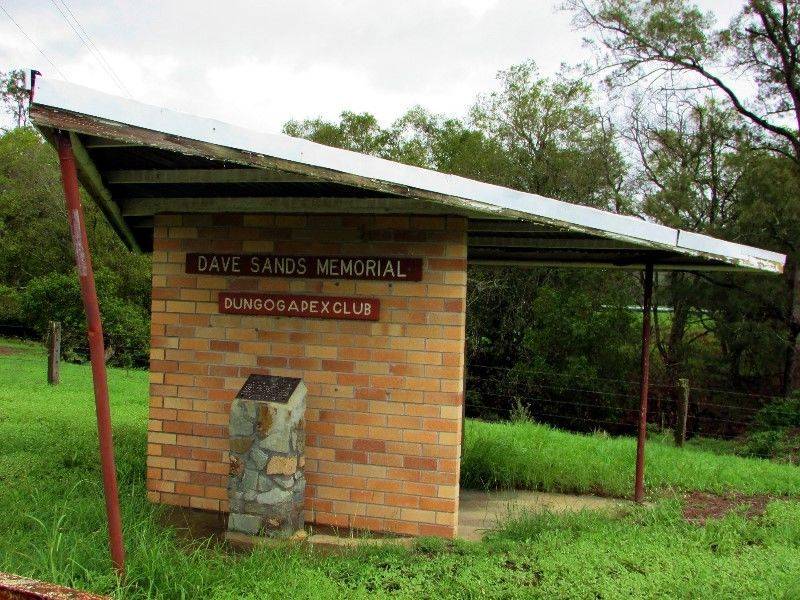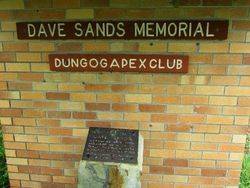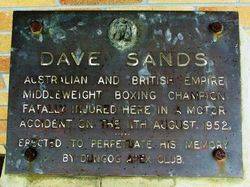
Dave SandsPrint Page 
The memorial commemorates indigenous boxer Dave Sands (1926 -1952), who was fatally injured in a road accident in 1952 near the site of the memorial. The memorial is located in a small shelter located at Dave Sands Reserve.
The man the Americans called the "boxer with the educated left hand" received his due when he was inducted into the World Boxing Hall of Fame in 1998 at a ceremony held in Los Angeles, recognised as one of the greatest boxers never to have won a world title. Dave was the 2009 Inductee for the Australian National Boxing Hall of FameVeterans category.
Sands' brothers Clement, Percival, George, Alfred and Russell also boxed, emulating their father and their maternal great-uncle Bailey Russell, a noted bare-knuckle fighter. In 1939 Percy travelled to Newcastle to train with Tom Maguire, At the age of 15 Sands joined Percy training with Maguire and both lived at Maguire's gym. Dave and his five brothers took on the Sands name, taken off a train guard "Snowy" Sands who helped Percy Ritchie, travel to fight fare free in 1940.
Sands was soon boxing in twelve-round matches before excited crowds of up to ten thousand people in Brisbane and Sydney. In May 1946 he defeated Jack Kirkham for the Australian middleweight title. Three months later he knocked out Jack Johnson in four rounds to become national light-heavyweight champion. The rematches were even more one-sided: Kirkham was defeated in five rounds and Johnson fell after 2½ minutes of furious punching. By 1948 Sands had beaten all his local opponents and most American 'imports'. His mauling of a French fighter Tony Toniolo in less than two minutes in February 1949 led the English promoter Jack Solomons to take an interest in him.
Despite an enthusiastic reception from the British press, Sands began his campaign for a world title disastrously. In London on 4 April 1949, while suffering from a swollen, recently vaccinated arm, he was outpointed by Tommy Yarosz. Fifteen days later Sands won, dismally, against a spoiler, Lucien Caboche. Maguire then moved him to Newcastle upon Tyne, where friendly locals and a promoter Joe Shepherd restored his confidence. After two solid victories, he returned to London and in July thrashed the much fancied Robert Villemain in the 'fight of the year'. On 6 September Sands demolished Dick Turpin in 2 minutes 35 seconds for the British Empire middleweight title.
Shortly after his triumphal return to Australia in November 1949, Sands survived a serious accident when the steering on his motorcar failed and the vehicle somersaulted into a creek. Over the next eighteen months he contested and won nine fights, one of them a fifteen-rounder in September 1950 in which he took the Australian heavyweight championship from Alf Gallagher. Sands had become a leading contender for the world middleweight title and Maguire vainly sought to arrange a bout with the American champion 'Sugar' Ray Robinson. In the tricky maze of international boxing-promotion, his efforts were marked by a 'paper-chase' of offers and counter-offers. Sands defeated Mel Brown in London in July 1951 in a preliminary to a title-fight between Robinson and another contender Randolph Turpin. Had Maguire's negotiations succeeded, Sands would have been in Turpin's place and probably would have beaten an unfit Robinson, as did Turpin.
In October Sands won two fights in the United States of America. Back home, he hoped for a world title-bout, but he was estranged from Maguire. A new manager Bede Kerr reopened discussions with Robinson's connexions, but 'the chance never came'. On 11 August 1952 the truck Sands was driving overturned at roadworks near Dungog, New South Wales; he died of his injuries that evening in the local hospital and was buried in Sandgate cemetery, Newcastle. His wife, and their son and two daughters survived him; their third daughter was born in November. Sands had earned about £30,000, but it went on manager's fees, travel costs, tax, family expenses and generosity to his kin. A public appeal raised more than £2500, sufficient to pay off his Stockton home and create a trust fund for his family.
Dave Sands was a consummate fighter-boxer. The most gifted of the Sands brothers, he was fast and quick-thinking, full of front-foot aggression and fierce counter-punching. He had the best left hook of his peers, and could punch heavily with both hands while absorbing the blows of the hardest hitters.
Sands fought 104 bouts: 60 won by knockouts, 33 won on points, one drawn, seven lost on points, one lost by a knockout, and two no-contests. According to Tatz, he was defeated only ten times in 110 fights.
Location
| Address: | Chichester Dam Road, Dave Sands Reserve, Bendolba, 2420 |
|---|---|
| State: | NSW |
| Area: | AUS |
| GPS Coordinates: | Lat: -32.350649 Long: 151.735993 Note: GPS Coordinates are approximate. |
Details
| Monument Type: | Monument |
|---|---|
| Monument Theme: | People |
| Sub-Theme: | Sport |
| Link: | http://adb.anu.edu.au/ |
Dedication
DAVE SANDS MEMORIAL
DUNGOG APEX CLUB
Plaque :
DAVE SANDS
Australian And British Empire
Middleweight Boxing Champion
Fatally Injured Here In A Motor
Accident On The 11th August, 1952.
Erected To Perpetuate His Memory
By Dungog APEX Club







